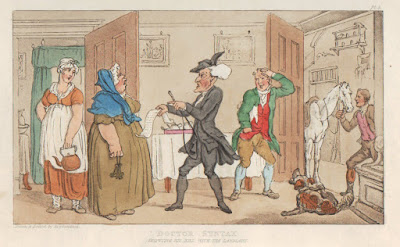On December 14, 1799, George Washington passed away at Mount Vernon and the nation went into deep mourning. Washington was a figure revered by most Americans so his death took on an almost religious aspect and citizens from all walks of life wanted to memorialize the “Father of his country.” Thus right from the start of the nineteenth century, there was a large outpouring of objects of art honoring his life and commemorating his death. These included drawings, paintings, needlework and embroidery, and—-of course-—
prints.
Interestingly, one of the first memorial prints of Washington was issued in London on April 10, 1800. Entitled “George Washington Late President of the United States,” it was engraved by P. Roberts and dedicated “to the friends of the Above Gentleman.” A bust portrait, based on a painting by American artist William Birch, is set into a scene with weapons of war and flags, giving Washington a setting of military glory.

Perhaps the earliest American morning print, “Sacred to the Memory of the truly Illustrious George Washington,” was designed by John Coles, Jr., engraved by Enoch G. Gridley, and published in Boston in July 1800. A large marble monument glorifies this “Great and Good Man.” A portrait of Washington, based on Edward Savages 1792 engraving, is held by Minerva, representing Washington’s military past. Fame hovers above the portrait blowing a trumpet from which hangs a banner listing Washington’s Revolutionary War triumphs. A weeping Columbia morns the loss of her son, as does a soldier standing in front of the monument.

Shortly after that print appear, in December 1800, this a stipple engraving by David Edwin, based on a drawing by Rembrandt Peale, was issued. Entitled “Apotheosis of Washington,” the President is shown rising to heaven from Mount Vernon (shown in the bottom right of the image) with a cherubim holding above his head a wreath of Immortality. Two figures look on, welcoming Washington, representing two slain Revolutionary War generals, Richard Montgomery and Joseph Warren.

The notion of the apotheosis of Washington led to the publication, in 1802, of another print on this theme, based on another important American artist of the period, John James Barralet. The initial advertisement for the print described it thusly, “The subject—General Washington raised from the tomb, by the spiritual and temporal Genius [that is ‘Father Time’]—assisted by Immortality. At his feet America weeping over his Armour, holding the staff surmounted by the cap of Liberty, emblematical of his mild administration, on the opposite side, an Indian crouched in surly sorrow. In the third ground the mental virtues, Faith, Hope, and Charity.” Other symbols in the picture include several representations of the Washington’s country; the American Eagle and Crest, as well as rattlesnakes, which referred to America’s revolutionary spirit. This print was so popular that it went through at least four states and was copied into other forms, including transfer china.

A number of prints focused on the fact that the people of the United States continued to mourn for Washington. This print by Boston printmaker Thomas Clarke, issued in 1801, shows a man and woman weeping into handkerchiefs while being consoled by a figure of Hope, who points to heaven and has the symbol of an anchor (“Hope...as an anchor of the soul.”). A monument to Washington, with his face engraved below a cherubim is set below a weeping willow.

The publication of Washington mourning images slowed down for a number of years, but the renewed patriotism motivated by the War of 1812 inspired a new group of such prints. One of these was a calligraphic image, a popular type of print at the time. This was drawn and published by Benjamin O. Tyler, “Professor of Penmanship,” in 1817, engraved by Peter Maverick. The print is entitled “Eulogium Sacred to the Memory of the Illustrious George Washington, Columbia’s Great and Successful Son: Honored Be His Name,” and in it Tyler uses clever symbols and other images.

This sort of print remained popular, as demonstrated by a second calligraphic memorial print, “Sacred to the Memory of the Illustrious Champion of Liberty, General George Washington; First President of the United States of America, issued about two decades later by John I. Donlevy. The face of the portrait is done with straight engraving, but the rest of the bust is made up of effusive swirls, and the writing gives the title and dates in Washington’s life.

Another print from the 1830s was a third apotheosis print, a lithograph issued in London based on a painting by Samuel Moore. The image is explicated by text at the bottom, but the image is readily understood even today. At the top, Washington is being born to heaven by the seven virtues, "the inmates of his Soul in his terrestial Pilgrimmage." Beneath, just below the American crest with its eagle, stands Columbia, "who looks up to him [Washington] as the rock of her consolation." In the foreground are shown the sixteen "Orphan States, dissolving in sorrow at his Tomb, and lamenting the departure of their adored Friend, Benefactor, and Protector." This refers to the sixteen state which were part of the U.S. at the time of Washington’s death.



















































